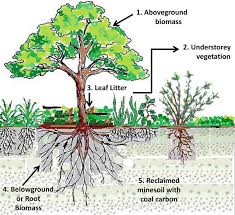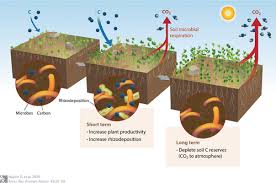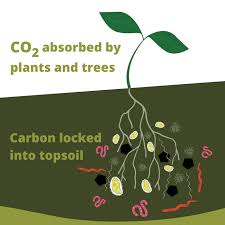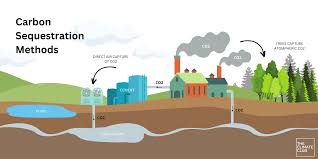Carbon sequestration is the process of capturing and storing atmospheric carbon dioxide (CO₂) in various reservoirs such as forests, oceans, and soils.
It plays a crucial role in mitigating climate change by reducing the amount of CO₂, a key greenhouse gas, in the atmosphere. Soils are particularly important in this process as they have the capacity to store vast amounts of carbon in the form of organic matter and minerals.
Enhancing carbon sequestration in soils is a key strategy in efforts to combat global warming and restore ecological balance.
The process of carbon sequestration occurs both naturally and through human intervention. Natural sequestration involves the absorption of carbon by plants through photosynthesis and its eventual storage in soils as plant matter decomposes.
Human activities, such as sustainable agricultural practices, forest restoration, and reforestation, can significantly enhance the ability of soils to sequester carbon, providing a long-term solution to reduce atmospheric carbon levels.
In this context, soil carbon sequestration is increasingly recognized as a cost-effective and sustainable approach to address climate change, improve soil health, and increase agricultural productivity. This section explores the role of soils in carbon storage, the mechanisms involved, and the factors that influence the effectiveness of carbon sequestration in soils.
The Role of Soils in Carbon Storage

Soils are one of the largest carbon reservoirs on Earth, containing more carbon than the atmosphere and all plant life combined. The carbon stored in soils is in the form of organic matter, which results from the decomposition of plants, animals, and microorganisms.
The capacity of soils to store carbon is influenced by a variety of factors, including soil type, land management practices, and climate conditions. Soils act as carbon sinks, which means they absorb more carbon than they release, playing a crucial role in regulating the carbon cycle.
1. Soil Organic Matter (SOM): Soil organic matter is the primary source of carbon storage in soils. It consists of decomposed plant and animal material, along with microorganisms such as bacteria and fungi.
The accumulation of organic matter in soils occurs as plants absorb CO₂ from the atmosphere through photosynthesis and transfer carbon to the soil via their roots, leaves, and other plant parts. As plant material decays, it is broken down into organic matter that can remain in the soil for long periods, contributing to carbon sequestration.
2. Carbon Sinks: Soils function as carbon sinks by capturing carbon from the atmosphere and storing it in a stable form. Forest soils, grasslands, wetlands, and peatlands are particularly effective at sequestering carbon. For example, forest soils can store large amounts of carbon through the decomposition of leaf litter and deadwood, while wetlands store carbon in the form of partially decomposed plant material known as peat.
3. Long-Term Carbon Storage: Carbon stored in soils can remain there for centuries or even millennia, depending on environmental conditions and land use practices. Some forms of soil carbon, such as humus, are very stable and resistant to decomposition, making them valuable in long-term carbon sequestration efforts.
Read Also: Vanilla Flower (Vanilla planifolia): All You Need To Know About
Importance of Healthy Soils for Carbon Sequestration

Healthy soils are essential for effective carbon sequestration. Soils that are rich in organic matter and have a good structure not only store more carbon but also support plant growth, enhance biodiversity, and improve water retention.
The health of soils is closely linked to their ability to sequester carbon, and practices that promote soil health can simultaneously boost carbon storage and enhance agricultural productivity.
1. Soil Structure: Soil structure refers to the arrangement of soil particles and the spaces between them. A well-structured soil has good porosity, allowing air and water to move freely through it, which is essential for plant growth and microbial activity. Healthy soils with a good structure can store carbon more effectively, as they provide a stable environment for organic matter to accumulate and resist erosion, which can cause carbon loss.
2. Biodiversity: The presence of a diverse community of microorganisms, plants, and animals in the soil enhances its ability to sequester carbon. Microorganisms play a crucial role in breaking down organic matter and transforming it into stable forms of carbon that can be stored in the soil. A rich and diverse soil ecosystem promotes the efficient cycling of carbon, nitrogen, and other nutrients, contributing to the long-term storage of carbon.
3. Sustainable Agriculture: Sustainable agricultural practices such as crop rotation, reduced tillage, cover cropping, and the use of organic fertilizers improve soil health and enhance carbon sequestration.
These practices increase the organic matter content of soils, reduce soil erosion, and promote the formation of stable carbon compounds that are resistant to decomposition. By adopting sustainable farming practices, farmers can contribute to climate change mitigation while improving the productivity and resilience of their land.
Mechanisms of Carbon Sequestration in Soils
Carbon sequestration in soils occurs through several interconnected mechanisms that involve the absorption of CO₂ by plants, its transformation into organic matter, and its stabilization in the soil.
These mechanisms ensure that carbon remains stored in the soil for extended periods, reducing its release into the atmosphere.
1. Photosynthesis: The process of photosynthesis is the starting point for soil carbon sequestration. Plants absorb CO₂ from the atmosphere and use sunlight to convert it into carbohydrates, which are then used for growth.
A portion of the carbon absorbed by plants is transferred to the soil through their roots, where it contributes to the formation of soil organic matter.
2. Humification: Humification is the process by which organic matter decomposes into humus, a stable and highly resistant form of carbon. Humus binds to soil particles, protecting it from further decomposition and ensuring that carbon remains stored in the soil for long periods.
Humification is a critical mechanism for long-term carbon sequestration, as it prevents the rapid breakdown of organic matter and the release of CO₂ back into the atmosphere
3. Microbial Activity: Soil microorganisms, including bacteria and fungi, play a key role in the decomposition of organic matter and the formation of stable carbon compounds.
As microorganisms break down plant and animal material, they transform carbon into forms that are less prone to decomposition, ensuring its long-term storage in the soil. Microbial activity also contributes to the formation of soil aggregates, which protect organic matter from erosion and further degradation.
4. Mineral Carbonation: In addition to organic matter, carbon can also be stored in soils in the form of mineral carbon compounds. Carbon can react with minerals in the soil to form stable carbonates, which are resistant to decomposition and can remain in the soil for millennia.
This process, known as mineral carbonation, is an important mechanism for sequestering carbon in soils with high mineral content, such as clay soils.
Read Also: Significance And Uses of Zantedeschia Aethiopica Flower
Factors Influencing Soil Carbon Sequestration

The ability of soils to sequester carbon is influenced by a range of factors, including soil type, climate, land use practices, and vegetation cover. Understanding these factors is essential for designing effective strategies to enhance soil carbon sequestration.
1. Soil Type: Different soil types have varying capacities to store carbon. Soils rich in clay, for example, have a higher capacity to sequester carbon because clay particles protect organic matter from decomposition by binding it tightly to soil minerals. In contrast, sandy soils may have a lower carbon storage capacity because they have less organic matter and are more prone to erosion.
2. Climate: Climate plays a significant role in determining the rate of carbon sequestration in soils. Cooler and wetter climates tend to promote higher rates of carbon storage because decomposition is slower, allowing organic matter to accumulate in the soil. In warmer and drier climates, decomposition occurs more rapidly, reducing the amount of carbon that can be stored in the soil.
3. Land Use Practices: Human activities such as agriculture, deforestation, and land degradation can have a profound impact on soil carbon sequestration. Unsustainable farming practices, such as overgrazing and excessive tillage, can deplete soil organic matter and reduce the ability of soils to sequester carbon. Conversely, adopting sustainable land management practices, such as agroforestry, cover cropping, and conservation tillage, can enhance soil carbon storage.
4. Vegetation Cover: The type and density of vegetation growing on the soil influence the amount of carbon that can be sequestered. Forests, grasslands, and wetlands are particularly effective at capturing and storing carbon due to their high levels of plant biomass and organic matter. Maintaining or restoring vegetation cover is essential for maximizing soil carbon sequestration.
Soils play a vital role in carbon sequestration, offering a natural solution to mitigate climate change. Healthy soils with good structure, rich biodiversity, and sustainable land management practices are key to enhancing the ability of soils to capture and store carbon.
Agricultural Practices that Enhance Soil Carbon Storage
1. Conservation Tillage: This practice involves reducing the frequency and intensity of tillage operations. By disturbing the soil less, conservation tillage helps to maintain organic matter, reduce erosion, and improve soil structure. This leads to greater carbon retention as the soil remains more stable and can store more carbon over time.
2. Cover Cropping: Planting cover crops during the off-season helps protect the soil from erosion and compaction. These crops, such as clover or rye, grow in the fall and winter, preventing nutrient leaching and adding organic matter when they decompose. This improves soil health and increases carbon content, contributing to better nutrient cycling.
3. Crop Rotation: Rotating different crops in a field from season to season helps maintain soil fertility and reduce pest and disease pressures. Different crops have varying root structures and nutrient requirements, which can improve soil health and structure. This diversity contributes to higher organic matter levels and enhances carbon sequestration capabilities.
4. Agroforestry: Integrating trees and shrubs into agricultural systems provides multiple benefits, including shade, windbreaks, and improved biodiversity. Trees capture carbon in their biomass and help store carbon in the soil through leaf litter and root decay. Agroforestry systems can enhance overall productivity while contributing to climate change mitigation.
5. Organic Farming: This farming method emphasizes the use of natural inputs, such as compost and cover crops, rather than synthetic fertilizers and pesticides. Organic practices improve soil structure and health, leading to higher organic matter content and increased carbon storage capacity. Healthy soils also support better crop yields and resilience against pests.
6. Managed Grazing: This strategy involves rotating livestock among different pastures to prevent overgrazing and promote grassland recovery. By allowing grasses to regrow, managed grazing enhances root systems and organic matter in the soil, which can increase carbon sequestration. Healthy grasslands play a vital role in capturing carbon dioxide from the atmosphere.
7. Composting: Adding compost to soil is an effective way to improve soil fertility and structure. Compost increases the organic matter content of the soil, which enhances its ability to sequester carbon. Additionally, composting reduces waste by recycling organic materials, contributing to a more sustainable farming system.
Benefits of Carbon Sequestration in Soils
1. Climate Change Mitigation: By storing carbon in the soil, agricultural practices can significantly reduce the amount of greenhouse gases in the atmosphere. This helps mitigate climate change impacts and fosters a more sustainable environment.
2. Enhanced Soil Health: Higher levels of organic matter improve soil structure, water retention, and nutrient availability. Healthier soils support better crop growth and resilience to extreme weather conditions, which is crucial in a changing climate.
3. Increased Agricultural Productivity: Soils rich in organic matter are more fertile, which can lead to higher crop yields. Farmers benefit economically from better productivity, while consumers enjoy a more stable food supply.
4. Biodiversity Conservation: Healthy soils promote diverse ecosystems, providing habitats for various organisms, including beneficial microbes, insects, and plants. This biodiversity is essential for maintaining ecological balance and resilience.
5. Erosion Prevention: Soils with good structure and organic matter content are less prone to erosion. Practices that enhance soil carbon storage help bind soil particles, reducing loss of topsoil and maintaining land productivity.
6. Water Retention and Drought Resilience: Increased organic matter improves the soil’s ability to hold water, making crops more resilient to drought conditions. This is particularly important in regions experiencing changing rainfall patterns.
Challenges in Maximizing Soil Carbon Sequestration
1. Measurement and Monitoring: Accurately quantifying the amount of carbon stored in soils is complex and often requires sophisticated methods. Variability in soil types and management practices complicates assessments.
2. Land Use Changes: Converting natural habitats to agricultural land can decrease soil carbon storage potential. Deforestation, urbanization, and other land-use changes can lead to carbon losses from soils.
3. Soil Degradation: Unsustainable farming practices, such as excessive tillage and chemical inputs, can degrade soil health and reduce its carbon storage capacity. This is often compounded by erosion and nutrient depletion.
4. Climate Variability: Changes in temperature and precipitation patterns can influence soil carbon dynamics. Extreme weather events, such as floods and droughts, can disrupt carbon sequestration processes.
5. Economic Constraints: Implementing sustainable practices may require upfront investment in new technologies and training. Farmers may face financial barriers to adopting practices that enhance carbon storage.
Strategies for Improving Soil Health and Carbon Sequestration
1. Incentivizing Sustainable Agriculture: Providing financial incentives, such as subsidies or grants, can encourage farmers to adopt practices that enhance carbon sequestration. This can promote a shift towards more sustainable farming methods.
2. Research and Innovation: Investing in research to develop new technologies and methods for improving soil health can enhance carbon sequestration. Innovative practices and tools can make sustainable agriculture more accessible.
3. Educating Farmers and Stakeholders: Training programs and workshops can equip farmers with knowledge about sustainable practices. Increased awareness of carbon sequestration benefits can lead to broader adoption of these practices.
4. Restoring Degraded Land: Efforts to rehabilitate degraded land, such as reforestation and implementing soil conservation techniques, can restore carbon-sequestering potential. Restoration projects benefit ecosystems and improve land productivity.
5. Promoting Agroecology and Regenerative Agriculture: Encouraging practices that prioritize ecological balance and sustainability can enhance soil carbon storage. Regenerative approaches focus on improving soil health while maintaining agricultural productivity.
6. Policy Support: Government policies that promote sustainable land management, conservation practices, and carbon sequestration initiatives can facilitate the transition to more sustainable agricultural systems.
Do you have any questions, suggestions, or contributions? If so, please feel free to use the comment box below to share your thoughts. We also encourage you to kindly share this information with others who might benefit from it. Since we can’t reach everyone at once, we truly appreciate your help in spreading the word. Thank you so much for your support and for sharing!

